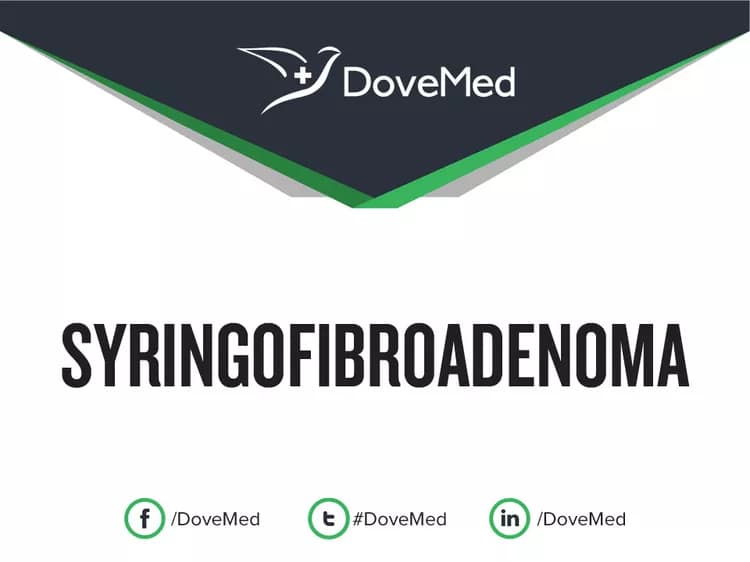What are the other Names for this Condition? (Also known as/Synonyms)
- Acrosyringeal Nevus of Weedon and Lewis
- Eccrine Syringofibroadenomatous Hyperplasia
- Syringofibroadenoma of Mascaro
What is Syringofibroadenoma? (Definition/Background Information)
- Syringofibroadenoma is a rare, benign tumor of eccrine origin. It arises from the eccrine sweat glands
- There are three different types of sweat glands in the skin. These include the following:
- Apocrine sweat glands
- Eccrine sweat glands
- Apoeccrine sweat glands
- Syringofibroadenoma is a slow-growing and usually solitary tumor that occurs as a painless nodule. It is seen in older adults, and is typically present on the arms and legs
- The cause of Syringofibroadenoma is largely unknown. Nevertheless, numerous risk factors have been identified that include nevus sebaceous, bullous pemphigoid, lichen planus, SCC of skin, etc.
- In a majority of cases no treatment is necessary, unless it causes worrisome symptoms or presents cosmetic concerns in the individual. A simple surgical excision of the tumor is considered curative
- The prognosis for Syringofibroadenoma is excellent with suitable treatment; however, the overall prognosis is also linked to the underlying condition (if any noted)
Who gets Syringofibroadenoma? (Age and Sex Distribution)
- Syringofibroadenoma is a rare condition that is present during adulthood; adults over 50 years are normally affected
- Both males and females may be affected
- Individuals of all racial and ethnic background may be affected. Worldwide, no geographical localization of Syringofibroadenoma has been reported
What are the Risk Factors for Syringofibroadenoma? (Predisposing Factors)
Currently, the following risk factors have been identified for Syringofibroadenoma:
- Bullous pemphigoid
- Lichen planus
- Skin ulceration
- Nevus sebaceous
- Squamous cell carcinoma of skin
- Longstanding lymphedema
- Schopf-Schulz-Passarge syndrome
It is important to note that having a risk factor does not mean that one will get the condition. A risk factor increases ones chances of getting a condition compared to an individual without the risk factors. Some risk factors are more important than others.
Also, not having a risk factor does not mean that an individual will not get the condition. It is always important to discuss the effect of risk factors with your healthcare provider.
What are the Causes of Syringofibroadenoma? (Etiology)
- The cause of development of Syringofibroadenoma is unknown
- However, because of its association with several risk factors (skin disorders and conditions), some researchers believe that Syringofibroadenoma is a hyperplasia of skin and not a ‘true tumor’
What are the Signs and Symptoms of Syringofibroadenoma?
The signs and symptoms of Syringofibroadenoma include:
- It usually occurs as a single nodule on the skin
- Rarely, multiple tumors are known to occur throughout the body. In such case, the condition is termed as Eccrine Syringofibroadenomatosis
- It is a slow-growing nodule that can range in size from 1-10 cm
- The tumor is usually painless and non-itchy
- Some tumors can be pigmented
- They are commonly observed on the arms and legs
How is Syringofibroadenoma Diagnosed?
A diagnosis of Syringofibroadenoma may involve the following:
- A thorough medical history and physical examination
- Dermoscopy: It is a diagnostic tool where a dermatologist examines the skin using a special magnified lens
- Wood’s lamp examination: In this procedure, the healthcare provider examines the skin using ultraviolet light. It is performed to examine the change in skin pigmentation
- Skin biopsy: A skin biopsy is performed and sent to a laboratory for a pathological examination. The pathologist examines the biopsy under a microscope. After putting together clinical findings, special studies on tissues (if needed) and with microscope findings, the pathologist arrives at a definitive diagnosis
Many clinical conditions may have similar signs and symptoms. Your healthcare provider may perform additional tests to rule out other clinical conditions to arrive at a definitive diagnosis.
What are the possible Complications of Syringofibroadenoma?
Syringofibroadenoma is a rare skin tumor and it may cause the following complications:
- The tumors can ulcerate and bleed, which can cause secondary bacterial or fungal infections to develop (superimposed infections)
- Some individuals may have concerns regarding their cosmetic appearance.
How is Syringofibroadenoma Treated?
The treatment of Syringofibroadenoma may involve the following:
- In a majority of cases, a removal of the tumor is not necessary, unless it causes bothersome signs and symptoms such as cosmetic issues
- The treatment is a complete surgical excision, which results in a cure
- Treatment of any underlying disorder(s) must be undertaken
- Follow-up care with regular screening and check-ups are important and encouraged
How can Syringofibroadenoma be Prevented?
Currently, there are no known methods to prevent the formation of a Syringofibroadenoma.
What is the Prognosis of Syringofibroadenoma? (Outcomes/Resolutions)
- The prognosis for Syringofibroadenoma is excellent with appropriate treatment, since it is a benign tumor
- However, the prognosis is also based upon the underlying syndrome and its severity
Additional and Relevant Useful Information for Syringofibroadenoma:
- There is no evidence to prove that oily foods and chocolate-based products have an influence on Syringofibroadenoma formation
- Cleaning the skin too hard with strong chemicals or soaps may aggravate the skin condition. Care must be taken avoid strong soaps and chemicals that could potentially worsen the condition
- The presence of dirt on the body is not a causative factor for the condition. However, it helps to be clean and hygienic, which may help the condition from getting worse
Related Articles
Test Your Knowledge
Asked by users
Related Centers
Related Specialties
Related Physicians
Related Procedures
Related Resources
Join DoveHubs
and connect with fellow professionals



0 Comments
Please log in to post a comment.